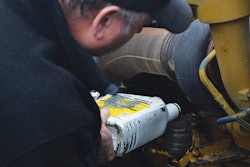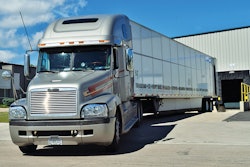PARTNERS IN BUSINESS TABLE OF CONTENTS »

The habit of saving for personal goals will pay big dividends later
As your business gets established and you can predict decent earnings on a regular basis, establish long-term personal savings plans and work a weekly or monthly savings contribution, however modest, into your budget. Retirement saving is critical for you as an owner-operator because you’re self-employed. Saving for children’s education, vacations or other personal goals also is important.
PLANNING FOR RETIREMENT
If you maintain your current spending and savings habits, will you have enough money to retire comfortably? A U.S. Department of Labor study found that Social Security will replace only about 40 percent of pre-retirement income for the average American. Yet experts say that after you retire, you’ll need about 70 percent of the income you earned before retirement to maintain your lifestyle.
At 70 percent, a trucker who earns $60,000 annually will need about $42,000 a year after he retires. When that figure is multiplied by 20 years — the average post-retirement longevity — that trucker will need about $840,000 to live comfortably. That entire amount doesn’t have to be saved in advance. Some of it would be income from investments during retirement.

Although it’s never too late to start saving for retirement, the sooner you begin, the better, even if it’s only $25 a week. The biggest reason is that invested money compounds. The earlier you invest, the more time your money has to grow.
If a 25-year-old puts $400 into a retirement fund every month until he reaches age 65, and his money grows 10 percent a year, he will retire with almost $2.5 million. If a 35-year-old invests the same amount each month and earns 10 percent, he will have a little more than $900,000 at age 65.
It’s hard to save on a regular basis. Yet average owner-operator clients of ATBS earn about $60,000 a year. At that level, the main difficulty is more about controlling spending.
Many owner-operators who don’t save say they’re investing their money in their business, with plans to sell it and retire on the proceeds. Financial advisers frown on such an eggs-in-one-basket approach. If your trucking business faces financial difficulties, then your retirement savings can be decreased substantially – or even wiped out. Think of your trucking business as only part of your portfolio – and a high-risk part at that.
QUALIFIED RETIREMENT PLANS
When you make investments that are not part of a retirement program, you’ll pay taxes on earnings, such as interest from a savings account or profit from a stock sale. With qualified retirement accounts, you don’t pay a penny in taxes on the earnings until you retire and begin withdrawing money. Not only are taxes delayed for many years, but by then you should be in a lower tax bracket, so you’ll pay less in taxes.
In addition, most retirement plans allow you to deduct contributions from your reported income. That means if you make $40,000 and contribute $2,000 to a qualified plan, you report only $38,000 on your income tax return.
The most popular qualified plans for owner-operators are Individual Retirement Accounts. Contributions can be put into certificates of deposit, money-market accounts, savings accounts, mutual funds, stocks, bonds and U.S. Treasury securities. A banker, stockbroker or mutual fund company can help you set up an IRA.
TRADITIONAL IRA. You are allowed to contribute $5,500 a year, tax-deferred, to an IRA, through tax year 2018 with a catch-up contribution limit of $1,000 for individuals age 50 and older. As long as you’re not covered by an employer-sponsored retirement plan, all contributions to an IRA reduce your taxable income and are tax-deferred. If you or your spouse contributes to an employer-sponsored plan such as a 401(k), only a portion of your contribution to an IRA is deductible. Your IRA funds cannot be withdrawn before you reach age 59.5 — except under special circumstances — without incurring a hefty penalty.
ROTH IRA. The differences between a traditional IRA and a Roth IRA are the terms of contributions and payout. With a Roth IRA, contributions are not deducted from income, so they are taxable for the year they’re earned. But they do accumulate tax-deferred, and are tax-free when withdrawn.
SIMPLE IRA. The SIMPLE (Savings Incentive Match Plan for Employees) IRA was designed for companies with fewer than 100 employees. If you employ others, you and your employees qualify. Under a SIMPLE IRA arrangement, an employee of your business can contribute to and be matched by you up to $12,500 in 2018, with a $3,000 catch-up contribution limit for those 50 and older.
SEP IRA. A Simplified Employee Pension plan allows an employer to contribute up to 25 percent of net income (up to $55,000 total) to an IRA set up for himself or his or her employees. After money is put into the plan, it must stay there until the owner turns 59.5. Early withdrawals are subject to federal income taxes and a possible 10 percent penalty.
INDIVIDUAL 401(k). For years, 401(k) retirement plans, another form of tax-deferred savings, were limited to employees, often with an employer match as a savings incentive. Since 2001, however, individuals have been free to set up solo 401(k)s, which have an annual contribution limit of up to 25 percent of income or $18,500, whichever is lower, in 2018, as long as you are classified as an employee of your own business (such as in an S Corp structure) and are paying yourself a salary. If you’re self-employed, the rules are more complicated. See IRS publication 560’s rate table and worksheets for determining your contribution limits.
ROTH 401(k). A newer retirement plan option is a combination of the Roth IRA and the solo 401(k) called the Roth 401(k): Money you put into it is taxed in the year you earned it, but never again. Many financial advisers believe a Roth 401(k) is by far the best deal for an owner-operator.
Assuming that taxes will go up in the long term is the safest of bets, so paying now locks in the lower rate. The more taxes you can pay while you’re younger, the better.
Download the entire Partners in Business Manual
Chapter 1: Becoming your own boss
Chapter 2: Bookkeeping and business analysis
Chapter 3: Understanding your revenue and costs
Chapter 5: Controlling fuel costs
Chapter 6: Controlling tire costs
Chapter 8: Income tax and other taxes
Chapter 9: Choosing a business structure
Chapter 10: Truck buying, leasing, financing
Chapter 11: Choosing a trailer
Chapter 12: Maintaining your equipment
Chapter 13: Choosing a carrier
Chapter 14: Computers, mobile devices and the internet
Chapter 15: Staying compliant and safe
Chapter 16: Trucking insurance








